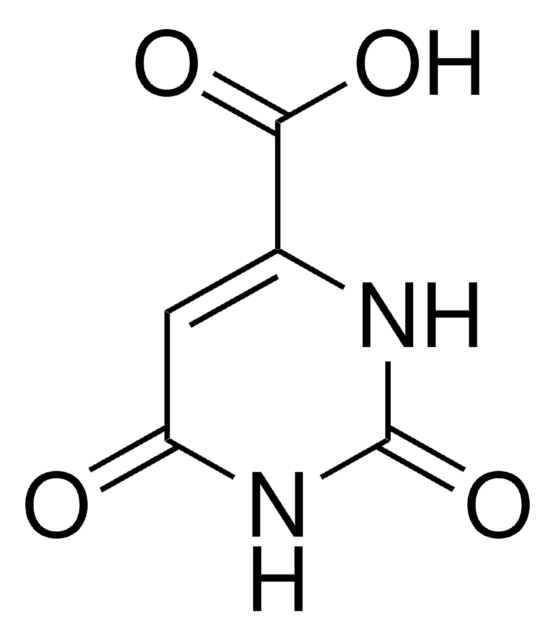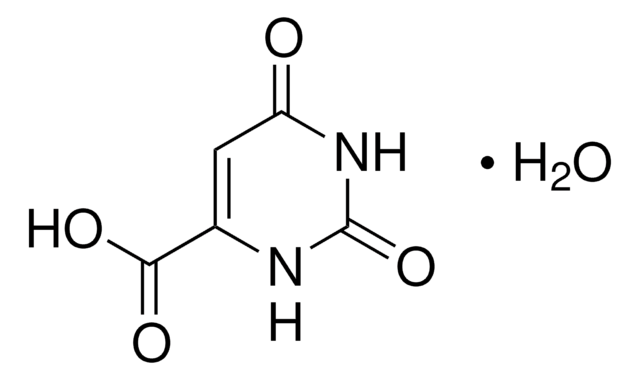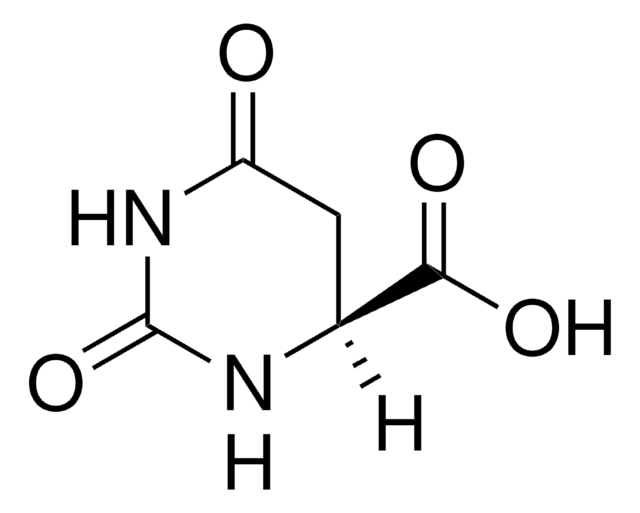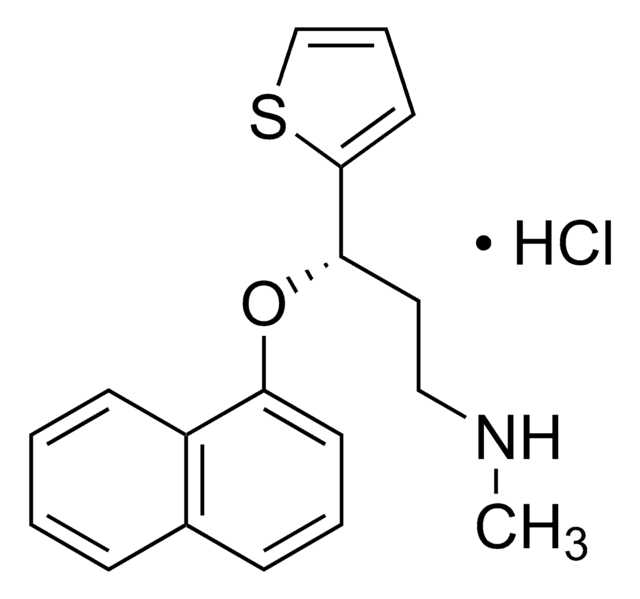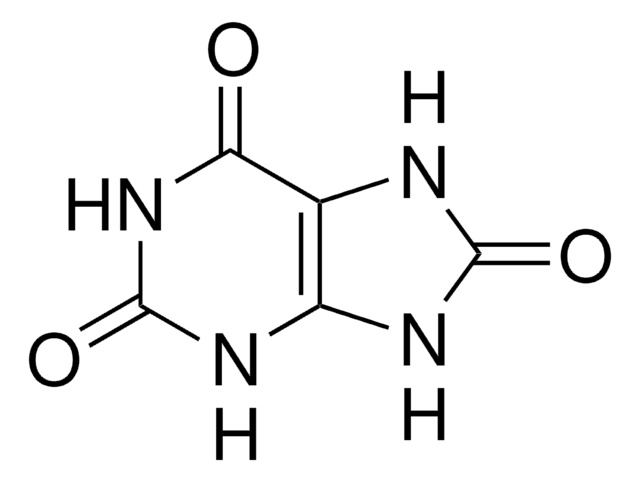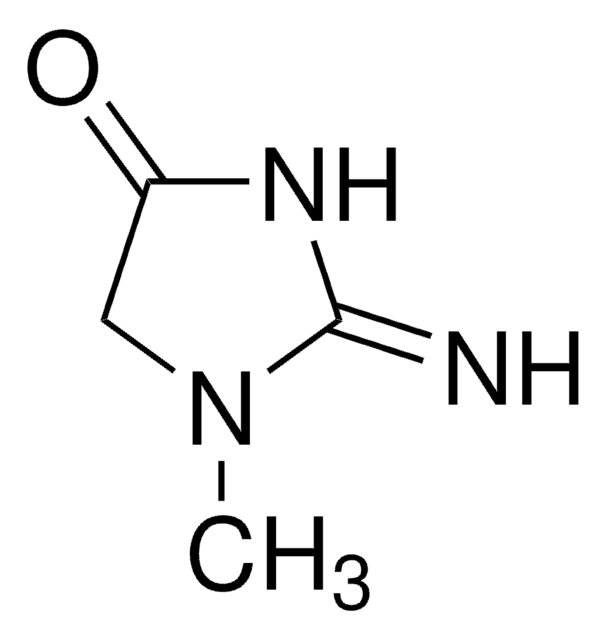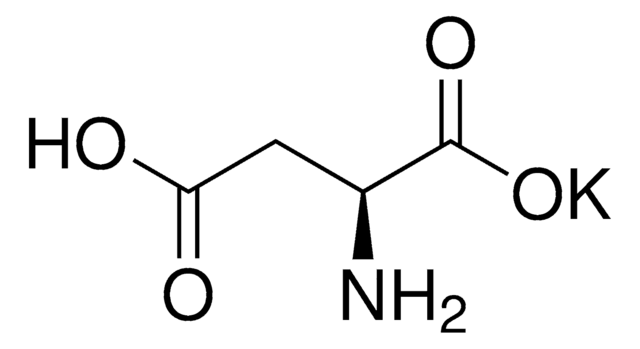O2875
Orotic acid potassium salt
≥98%
Sinonimo/i:
6-Carboxy-2,4-dihydroxypyrimidine, Uracil-6-carboxylic acid
Autenticatiper visualizzare i prezzi riservati alla tua organizzazione & contrattuali
About This Item
Formula condensata:
C5H3N2O4K
Numero CAS:
Peso molecolare:
194.19
Numero CE:
Numero MDL:
Codice UNSPSC:
41106305
ID PubChem:
NACRES:
NA.51
Prodotti consigliati
Saggio
≥98%
Stato
powder
Solubilità
1 M NaOH: 25 mg/mL, clear to slightly hazy, colorless to faintly yellow
Stringa SMILE
[K+].[O-]C(=O)C1=CC(=O)NC(=O)N1
InChI
1S/C5H4N2O4.K/c8-3-1-2(4(9)10)6-5(11)7-3;/h1H,(H,9,10)(H2,6,7,8,11);/q;+1/p-1
DHBUISJCVRMTAZ-UHFFFAOYSA-M
Applicazioni
Orotic acid (OA) is an intermediate in de novo pyrimidine biosynthesis that may be used to study the specificity and kinetics of orotate phosphoribosyltransferase (OPRT) which catalyzes the reversible phosphoribosyl transfer from 5′-phospho-α-d-ribose 1′-diphosphate (PRPP) to orotic acid (OA), forming pyrophosphate and orotidine 5′-monophosphate (OMP). Orotic acid is used as a starting material for the potential commercial bioproduction of uridine 5′-monophosphate (UMP) by microbes such as Corynebacterium ammoniagenes (ATCC 6872) or Saccharomyces cerevisiae. OA may be used to study the AMPK/SREBP-1 dependent cell signaling pathway and transcription regulation mechanisms that induce hepatic lipogenesis.
Codice della classe di stoccaggio
11 - Combustible Solids
Classe di pericolosità dell'acqua (WGK)
WGK 2
Punto d’infiammabilità (°F)
Not applicable
Punto d’infiammabilità (°C)
Not applicable
Dispositivi di protezione individuale
Eyeshields, Gloves, type N95 (US)
Scegli una delle versioni più recenti:
Possiedi già questo prodotto?
I documenti relativi ai prodotti acquistati recentemente sono disponibili nell’Archivio dei documenti.
I clienti hanno visto anche
Enhanced uridine 5'-monophosphate production by whole cell of Saccharomyces cerevisiae through rational redistribution of metabolic flux.
Liu D, Chen Y, Li A, Xie J, Xiong J, et al.
Bioprocess and Biosystems Engineering (2011)
Ardala Breda et al.
Molecular bioSystems, 8(2), 572-586 (2011-11-15)
Tuberculosis (TB) is a chronic infectious disease caused mainly by Mycobacterium tuberculosis. The worldwide emergence of drug-resistant strains, the increasing number of infected patients among immune compromised populations, and the large number of latent infected individuals that are reservoir to
Xing Wang et al.
Applied microbiology and biotechnology, 76(2), 321-328 (2007-05-24)
Attempts were made with success to develop a two-step biocatalytic process for uridine 5'-monophosphate (UMP) production from orotic acid by Corynebacterium ammoniagenes ATCC 6872: the strain was first cultivated in a high salt mineral medium, and then cells were harvested
Yong Chen et al.
Applied microbiology and biotechnology, 86(1), 75-81 (2009-10-15)
A whole cell biocatalytic process for uridine 5'-monophosphate (UMP) production from orotic acid by Saccharomyces cerevisiae was developed. The concentration of UMP was increased by 23% when 1 g l(-1) sodium citrate was fed into the broth. Effects of citrate
Eun-Jeong Jung et al.
Journal of lipid research, 52(9), 1617-1625 (2011-07-16)
Orotic acid (OA), an intermediate in pyrimidine metabolism, has been used for a variety of purposes, such as dietary supplements. Although it is well documented that OA induces fatty liver in a species-specific manner, the precise molecular mechanisms remain unclear.
Il team dei nostri ricercatori vanta grande esperienza in tutte le aree della ricerca quali Life Science, scienza dei materiali, sintesi chimica, cromatografia, discipline analitiche, ecc..
Contatta l'Assistenza Tecnica.